Numerical Simulation of Pore Pressure Change Caused by Hydrocarbon Generation in Chezhen Sag and Its Influence on Hydrocarbon Accumulation
Abstract
1. Introduction
2. Geological Background
3. Model Settings
3.1. Fault Sealing Properties
3.2. Finite Element Model
| Stratum | Young’s Modulus (GPa) | Poisson Ratio | Higher Permeability (m2) | Lower Permeability (m2) [38,39] |
|---|---|---|---|---|
| Ng | 30 [42] | 0.25 [42] | 1.5 × 10−15 | 1.5 × 10−20 |
| Ed | 32 [42] | 0.25 [42] | 1 × 10−15 | 1 × 10−20 |
| Es2 | 32 [42] | 0.25 [42] | 1 × 10−15 | 1 × 10−20 |
| Es3 | 35 [43] | 0.3 [43] | 5 × 10−15 | 5 × 10−20 |
| Es4 | 35 [43] | 0.3 [43] | 3 × 10−15 | 3 × 10−20 |
| C | 35 [44] | 0.3 [44] | 2 × 10−15 | 2 × 10−20 |
| O | 35 [44] | 0.3 [44] | 1 × 10−16 | 1 × 10−21 |
| 35 [44] | 0.35 [44] | 1 × 10−16 | 1 × 10−21 | |
| Art | 35 | 0.35 | 1 × 10−16 | 1 × 10−21 |
| Fault-L-Es3 | 35 [27] | 0.3 [27] | 1 × 10−12 | 1 × 10−17 |
| Fault-L-Es4 | 35 [27] | 0.3 [27] | 1 × 10−13 | 1 × 10−18 |
| Fault-R-Es3 | 35 [27] | 0.3 [27] | 1 × 10−12 | 1 × 10−17 |
| Fault-R-Es4 | 35 [27] | 0.3 [27] | 1 × 10−13 | 1 × 10−18 |
3.3. Governing Equations
3.3.1. Equilibrium Equation
3.3.2. Principle of Effective Stress
3.3.3. Constitutive Relations of Pore Fluids
3.3.4. Continuous Equation of Seepage
4. Model Results
5. Discussion
5.1. Effect of Fault Sealing on Hydrocarbon Accumulation
5.2. Influence of Formation Permeability on Hydrocarbon Accumulation
5.3. Quantitative Comparison of Hydrocarbon Generation Overpressure and Unbalanced Compaction Overpressure
5.4. Model Limitations
6. Conclusions
- (1)
- When a fault was open and had high permeability, it could serve as the major or dominant channel for hydrocarbon migration. Overpressure could then affect the direction and path of hydrocarbon migration. In the closed state of a fault, hydrocarbon migration was primarily driven by buoyancy, moving from deep source formations to shallow reservoirs, where it eventually accumulated. This process is characteristic of conventional petroleum reservoirs. Under the condition of a fault opening, hydrocarbons could not only be trapped in conventional reservoirs but could also migrate downward along the fault and eventually accumulate. Although this condition is more strict, this situation can still exist.
- (2)
- The overpressure could alter the direction and pathway of hydrocarbon migration, thereby promoting the migration of hydrocarbons and enhancing the efficiency of hydrocarbon accumulation. However, excessive pore fluid overpressure could lead to hydraulic fracturing or shear fractures in rocks, resulting in the formation of a fault system. This could cause the dissipation of hydrocarbons and prevent their accumulation.
- (3)
- The permeability of rock plays an important role in the generation and maintenance of overpressure and the mechanism of the accumulation mode. High-permeability rocks allowed for the rapid flow of hydrocarbons and rapid dissipation of overpressure, and did not form overpressure in the formation. In contrast, low-permeability rocks impeded the movement of hydrocarbons, causing them to accumulate slowly. This accumulation could lead to overpressure, which, in turn, promoted the downward migration and accumulation of hydrocarbons along faults.
Author Contributions
Funding
Data Availability Statement
Conflicts of Interest
Appendix A
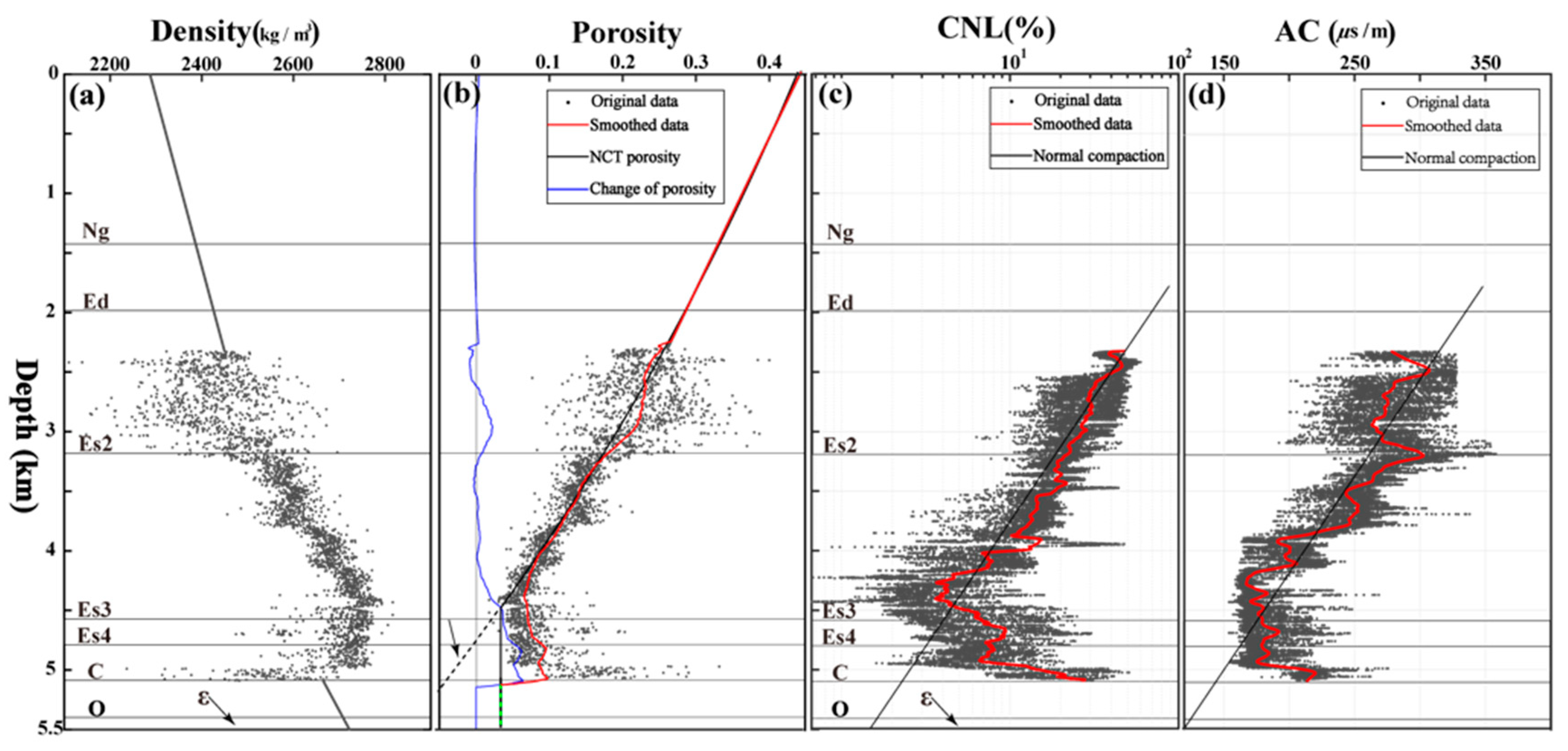
References
- Krayushkin, V.A. The plutonic oil-gas fields. Xinjiang Pet. Geol. 2009, 30, 136–141. (In Chinese) [Google Scholar]
- Jia, C.Z.; Pang, X.Q.; Jiang, F.J. Research status and development directions of hydrocarbon resources in China. Pet. Sci. 2016, 1, 2–23. [Google Scholar]
- Zou, C.N.; Tao, S.Z.; Bai, B.; Yang, Z.; Zhu, R.K.; Hou, L.H.; Yuan, X.J.; Zhang, G.S.; Wu, S.T.; Pang, Z.L.; et al. Differences and relations between unconventional and conventional Oil and Gas. China Pet. Explor. 2015, 20, 1–16. (In Chinese) [Google Scholar]
- Hunt, J.M. Generation and migration of petroleum from abnormally pressured fluid compartments. AAPG Bull. 1990, 74, 1–12. [Google Scholar]
- Hao, F.; Zou, H.Y.; Gong, Z.S.; Yang, S.G.; Zeng, Z.P. Hierarchies of overpressure retardation of organic matter maturation: Case studies from petroleum basins in China. AAPG Bull. 2007, 91, 1467–1498. [Google Scholar] [CrossRef]
- Li, C.; Zhang, L.; Luo, X.R.; Wang, B.; Lei, Y.H.; Cheng, M.; Luo, H.M.; Wang, C.J.; Yu, L. Modeling of Overpressure Generation–Evolution of the Paleogene Source Rock and Implications for the Linnan Sag, Eastern China. Front. Earth Sci. 2022, 10, 829322. [Google Scholar] [CrossRef]
- Chi, G.; Lavoie, D.; Bertrand, R.; Lee, M.K. Downward hydrocarbon migration predicted from numerical modeling of fluid overpressure in the Paleozoic Anticosti Basin, eastern Canada. Geofluids 2010, 10, 334–350. [Google Scholar] [CrossRef]
- Gao, C.W.; Luo, Q. A new plan for dividing source-reservoir-cap rock assemblage and its exploration meanings. Pet. Explor. Dev. 2022, 6, 29–31. [Google Scholar]
- Chi, Y.L.; Xiao, D.M.; Yin, J.Y. The Injection Pattern of Oil and Gas Migration and Accumulation in the Sanzhao Area of Songliao Basin. Acta Geol. Sin. 2000, 74, 371–377. (In Chinese) [Google Scholar]
- Lv, Y.F.; Li, J.M.; Fu, X.F.; Fu, G.; Wang, Y.G.; Xuan, C.J. Geologic conditions of oil gas downward discharging and exploration direction in the Sanzhao Sag, Songliao Basin. Chin. J. Geol. 2009, 2, 525–533. (In Chinese) [Google Scholar]
- Dubille, M.; Maury, G.; Al-Ali, S.A.K.; Alkhamiss, A. Downward Migration, Theory and Application to Najmah-Marrat Petroleum System. In Proceedings of the 79th EAGE Conference and Exhibition 2017, Paris, France, 12–15 June 2017; European Association of Geoscientists & Engineers: Utrecht, The Netherlands, 2017; Volume 2017, pp. 1–5. [Google Scholar]
- Tóth, J.; Maccagno, M.D.; Otto, C.J.; Rostron, B.J. Generation and migration of petroleum from abnormally pressured fluid compartments: Discussion. AAPG Bull. 1991, 75, 331–335. [Google Scholar]
- Zou, C.N.; Jia, C.Z.; Zhao, W.Z.; Tao, S.Z.; Gu, Z.D.; Hou, Q.J.; Zhao, Z.Y.; Song, L.Z. Accumulation dynamics and distribution of lithostratigraphic reservoirs in South Songliao Basin. Pet. Explo. Dev. 2005, 32, 2–20. [Google Scholar]
- Fu, G.; Wang, Y.G. Migration horizons downward of oil from k1-qn source rock of F, Y oil layer in sanzhao depression and its significance. Acta Sedimentol. Sin. 2008, 26, 355–360. (In Chinese) [Google Scholar]
- Xiang, L.H.; Hao, X.F. Hydrocarbon “downward migration” mechanism and maximum migration distance estimation in Chexi Sag. Spec. Oil Gas Reserv. 2016, 23, 34–37. (In Chinese) [Google Scholar]
- Shi, J.J.; Fu, G.; Li, L.L. The quantitative research of the downward migration distance and target horizons of K1 qn, oil and gas in Binbei area. Pet. Geol. Recovery Effic. 2009, 16, 26–29. (In Chinese) [Google Scholar]
- Feng, L.H. A method for upper and down expulsion hydrocarbon amount of overpressured sourcerock by interval transit time. J. Daqing Pet. Inst. 2007, 31, 22–24. (In Chinese) [Google Scholar]
- Zhuang, J.C.; Zhang, S.W.; Wang, Y.S.; Lin, H.X. Pressure fall model of hydrocarbon conducted by fault. Pet. Geol. Recovery Effic. 2008, 15, 46–48. (In Chinese) [Google Scholar]
- Wang, Y.S.; Shan, Y.X.; Lao, H.G. Physical Simulation of Oil and Gas Backflow and Its Geological Significance. J. Southwest Pet. Univ. (Sci. Technol. Ed.) 2014, 36, 45. (In Chinese) [Google Scholar]
- Luo, X.; Vasseur, G. Overpressure dissipation mechanisms in sedimentary sections consisting of alternating mud-sand layers. Mar. Pet. Geol. 2016, 78, 883–894. [Google Scholar] [CrossRef]
- Guo, X.; He, S.; Liu, K.; Song, G.; Wang, X.; Shi, Z. Oil generation as the dominant overpressure mechanism in the Cenozoic Dongying depression, Bohai Bay Basin, China. AAPG Bull. 2010, 94, 1859–1881. [Google Scholar] [CrossRef]
- Li, C.; Zhang, L.; Luo, X.R.; Lei, Y.H.; Yu, L.; Cheng, M.; Wang, Y.S.; Wang, Z.L. Overpressure generation by disequilibrium compaction or hydrocarbon generation in the Paleocene Shahejie Formation in the Chezhen Depression: Insights from logging responses and basin modeling. Mar. Pet. Geol. 2021, 133, 105258. [Google Scholar] [CrossRef]
- Wang, Y.L. Hydrocarbon Migration Dynamic Conditions and Accumulation Models of Lower Paleozoic in Chexi Area. Master’s Thesis, China University Petroleum (East China), Qingdao, China, 2016. (In Chinese). [Google Scholar]
- Li, C.; Luo, X.; Zhang, L.; Wang, B.; Guan, X.; Luo, H.; Lei, Y. Overpressure generation mechanisms and its distribution in the Paleocene Shahejie Formation in the Linnan sag, Huimin depression, eastern China. Energies 2019, 12, 3183. [Google Scholar] [CrossRef]
- Sun, Y.T.; Dong, L.F.; Liu, F.F.; Meng, T.; Zhang, B.; Shi, Q.Q. Tectonic evolution and dynamic origin mechanism in Chezhen Sag, Jiyang Depression (in Chinese). Chin. J. Geol. 2022, 57, 427–438. [Google Scholar]
- Liu, L.J.; Lin, C.S. The control effect of sedimentary filling patterns and fault slope break zones of sha 3 member of shahejie formation in Chezhen Sag, Jiyang Depression. J. Yangtze Univ. (Nat. Sci. Ed.) 2020, 17, 10–17. (In Chinese) [Google Scholar]
- Shang, L. Research on Developing Regularity of Multiperiod Structural Fractures in Futai Carbonate Buried Hill. Ph.D. Thesis, China University Petroleum (East China), Qingdao, China, 2014. (In Chinese). [Google Scholar]
- Wang, Y.S. Detachment buried-hill oil-gas reservoir forming pattern in half-graben fault depression lake basin-taking Futai oil field as example. Pet. Geol. Recovery Effic. 2004, 11, 13–15. (In Chinese) [Google Scholar]
- Liang, S.R. Geoburried-Hills Reservoir Characteristics and Forming-Mechanism in Chexi Are. Ph.D. Thesis, China University Petroleum (East China), Qingdao, China, 2007. (In Chinese). [Google Scholar]
- Jin, S.; Cao, H.; Wang, H.; Chen, S. The Paleogene multi-phase tectono-sedimentary evolution of the syn-rift stage in the Nanpu Sag, Bohai Bay Basin, East China. Energy Explor. Exploit. 2018, 36, 1519–1545. [Google Scholar] [CrossRef]
- Zhu, Y.G.; Jin, Q.; Zhang, Y.C.; Zhang, L.H.; Zhang, S.W.; Guo, C.C. Study on hydrocarbon generation system of Lower Tertiary Shahejie Formation in Chezhen depression. Nat. Gas Ind. 2006, 26, 19–22. (In Chinese) [Google Scholar]
- Zhang, J.Z.; Wang, Y.S.; Wang, X.J.; Cao, S.M.; Wang, X.F.; Bi, C.Q. Buried hill reservoir characteristic of the lower Palaeozoic in Futai oilfield. Pet. Geol. Recovery Effic. 2003, 04, 23–25+5. [Google Scholar]
- Ma, L.C.; Wang, Y.S.; Jing, A.Y. New understanding and discovery in exploration of Lower Paleozoic buried hills in Jiyang Depression, Bohai Bay Basin. Pet. Geol. Recovery Effic. 2021, 28, 10–16. (In Chinese) [Google Scholar]
- Xue, H.T.; Lu, S.F.; Zhang, X.J.; Li, Z.; Shen, J.N. Evaluation of Lower Paleozoic carbonate source rocks in Jiyang depression. Geochimica 2006, 35, 609–614. [Google Scholar]
- Chester, F.M.; Evans, J.P.; Biegel, R.L. Internal structure and weakening mechanisms of the San Andreas fault. J. Geophys. Res.-Solid Earth 1993, 98, 771–786. [Google Scholar] [CrossRef]
- Caine, J.S.; Evans, J.P.; Forster, C.B. Fault zone architecture and permeability structure. Geology 1996, 24, 1025–1028. [Google Scholar] [CrossRef]
- Liao, Z.H.; Liu, H.; Carpenter, B.M.; Marfurt, K.J.; Reches, Z.E. Analysis of fault damage zones using three-dimensional seismic coherence in the Anadarko Basin, Oklahoma. AAPG Bull. 2019, 103, 1771–1785. [Google Scholar] [CrossRef]
- Gao, B.; Flemings, P.B. Pore pressure within dipping reservoirs in overpressured basins. Mar. Pet. Geol. 2017, 80, 94–111. [Google Scholar] [CrossRef]
- Luo, G.; Flemings, P.B.; Hudec, M.R.; Nikolinakou, M.A. The role of pore fluid overpressure in the substrates of advancing salt sheets, ice glaciers, and critical-state wedges. J. Geophys. Res.-Solid Earth 2015, 120, 87–105. [Google Scholar] [CrossRef]
- Chen, J.Y.; Yang, X.S.; Dang, J.X.; He, C.R.; Zhou, Y.S.; Ma, S.L. Internal structure and permeability of Wenchuan earthquake fault (in Chinese). Chin. J. Geophys. 2011, 54, 1805–1816. [Google Scholar]
- Zhang, J.L.; He, S.; Wang, Y.Q.; Hao, X.F.; Luo, S.Y.; Li, P.; Dang, X.W.; Yang, R.Z. Main mechanism for generating overpressure in the Paleogene source rock series of the Chezhen depression, Bohai Bay Basin. J. Earth Sci. 2019, 30, 775–787. [Google Scholar] [CrossRef]
- Feng, J.; Qu, J.; Wan, H.; Ren, Q.Q. Quantitative prediction of multiperiod fracture distributions in the Cambrian-Ordovician buried hill within the Futai Oilfield, Jiyang Depression, East China. J. Struct Geol. 2021, 148, 104359. [Google Scholar] [CrossRef]
- Wu, G.C.; Zhao, X.L.; Tang, J.; Du, Z.Y. First-order perturbation approximation for rock elastic moduli in transversely isotropic media. Sci. China Earth Sci. 2017, 60, 1645–1654. [Google Scholar] [CrossRef]
- Duan, Q.B.; Yang, X.S.; Chen, J.Y. A preliminary experimental study on permeability of samples collected from Wenchuan earthquake fault zone. Prog. Earthq. Sci. 2012, 6, 55. [Google Scholar]
- Terzaghi, K. Theoretical Soil Mechanics; John Wiley and Sons, Inc.: New York, NY, USA, 1948. [Google Scholar]
- Nur, A.; Byerlee, J.D. An exact effective stress law for elastic deformation of rock with fluids. J. Geophys. Res. 1971, 76, 6414–6419. [Google Scholar] [CrossRef]
- Fjaer, E.; Holt, R.M.; Horsrud, P.; Raaen, A.M. Petroleum Related Rock Mechanics; Elsevier: Amsterdam, The Netherlands, 1992; Volume 33. [Google Scholar]
- Chang, C.; Luo, G.; Wang, M.W.; Sun, Y.Q. Near-salt perturbations of stresses and pore fluid pressures and their impacts on wellbore stability in the Kuqa depression of the Tarim Basin, China. Interpretation 2020, 8, SG33–SG49. [Google Scholar] [CrossRef]
- Joshua, P.E. Coupled Fluid Flow and Geomechanical Modeling of Fault Activated Induced Seismicity. Ph.D. Thesis, Texas A&M University, College Station, TX, USA, 2018. [Google Scholar]
- Zhang, H.Y. Fluid Mechanics; Science Press: Beijing, China, 2004. [Google Scholar]
- Simulia. Abaqus, a General Purpose Finite Element Analysis Code: Dassault Systémes Simulia Corp. 2016. Available online: https://www.simulia.com (accessed on 18 December 2018).
- Yu, L.G. The FEM simulating of hydrocarbon migration in dongying depression. Master’s Thesis, China University Petroleum (East China), Qingdao, China, 2007. (In Chinese). [Google Scholar]
- Xie, X.N.; Li, S.T.; Liu, X.F. Fluid Dynamics of Abnormal Pressure Basin; China University of Geosciences Press: Beijing, China, 2006. [Google Scholar]
- Hubbert, M.K.; Willis, D.G. Mechanics of hydraulic fracturing. Trans. AIME 1957, 210, 153–168. [Google Scholar] [CrossRef]
- Osiptsov, A.A. Fluid mechanics of hydraulic fracturing: A review. J. Pet. Sci. Eng. 2017, 156, 513–535. [Google Scholar] [CrossRef]
- Pratsch, J.C. Focused gas migration and concentration of deep-gas accumulations. Erdoel Kohle Erdgas Petrochem. Brennst.-Chem. (Ger. Fed. Repub.) 1982, 35, 59–65. [Google Scholar]
- Hindle, A.D. Petroleum migration pathways and charge concentration: A three-dimensional model. AAPG Bull. 1997, 81, 1451–1481. [Google Scholar]
- Luo, G.; Hudec, M.R.; Flemings, P.B. Deformation, stress, and pore pressure in an evolving suprasalt basin. J. Geophys. Res.-Solid Earth 2017, 122, 5663–5690. [Google Scholar] [CrossRef]
- Xiang, L.H.; Wang, X.J.; Hao, X.F.; Li, X.Y. The study of reservoir forming conditions about hc migration downward in chexi sag. Offshore Oil 2013, 33, 42–47. (In Chinese) [Google Scholar]
- Nikolinakou, M.A.; Heidari, M.; Flemings, P.B. Geomechanical modeling of pore pressure in evolving salt systems. Mar. Pet. Geol. 2018, 93, 272–286. [Google Scholar] [CrossRef]
- Revil, A.; Pezard, P.A.; de Larouzière, F.D. 10. Fluid overpressures in western mediterranean sediments. SITES 974–979 1999, 48, 697–709. [Google Scholar]
- Tingay, M.R.; Hillis, R.R.; Swarbrick, R.E.; Morley, C.K.; Damit, A.R. Origin of Overpressure and Pore-Pressure Prediction in the Baram Province, Brunei. AAPG Bull. 2009, 93, 51–74. [Google Scholar] [CrossRef]
- Sharp, J.M. Momentum and Energy Balance Equations for Compacting Sediments. J. Int. Assoc. Math. Geol. 1976, 98, 305–322. [Google Scholar] [CrossRef]
- Rubey, W.W.; Hubbert, M.K. Role of fluid pressure in mechanics of overthrust faulting, II. Overthrust Belt in geosynclinal area of western Wyoming in light of fluid-pressure hypothesis. AAPG Bull. 1959, 70, 167–205. [Google Scholar]
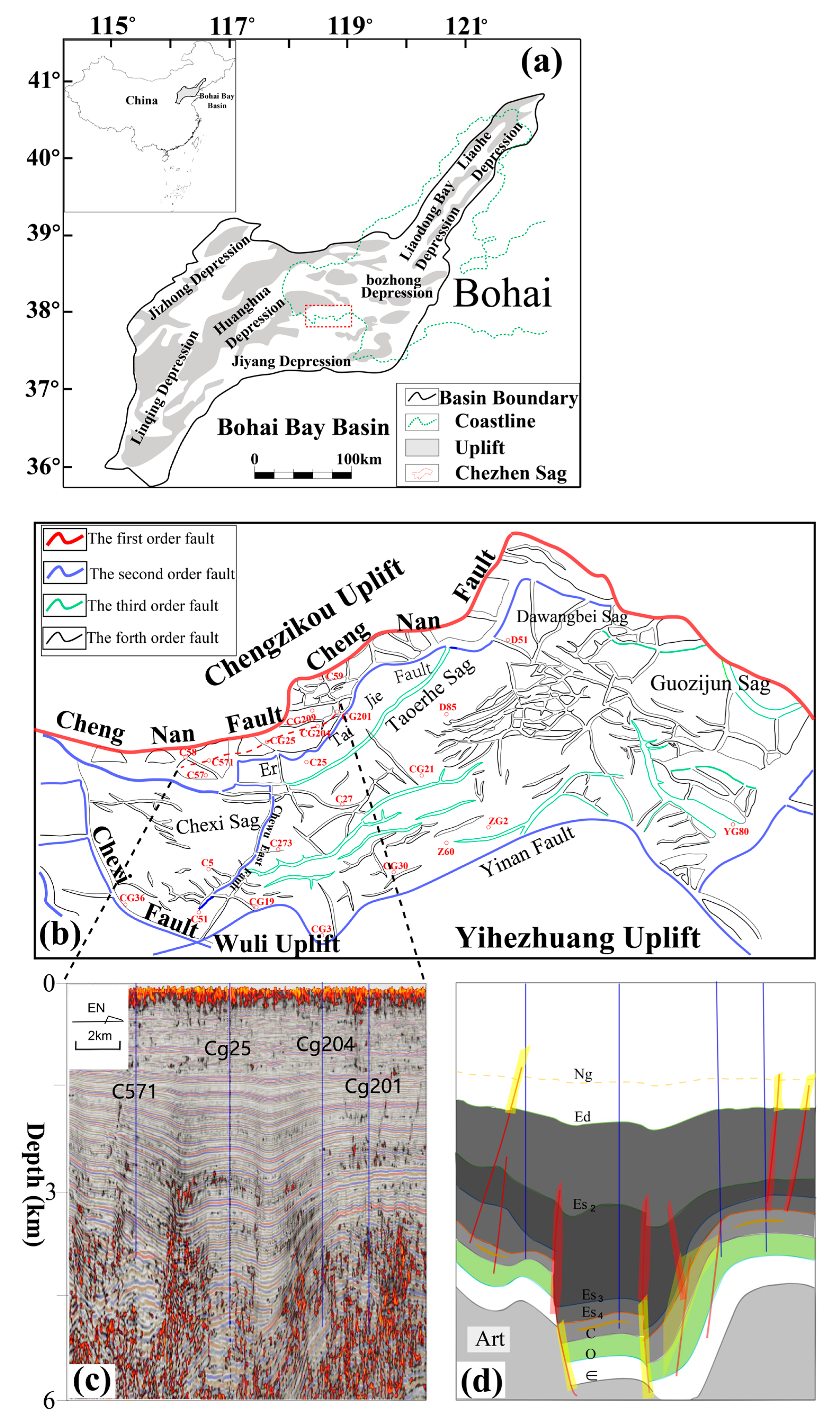
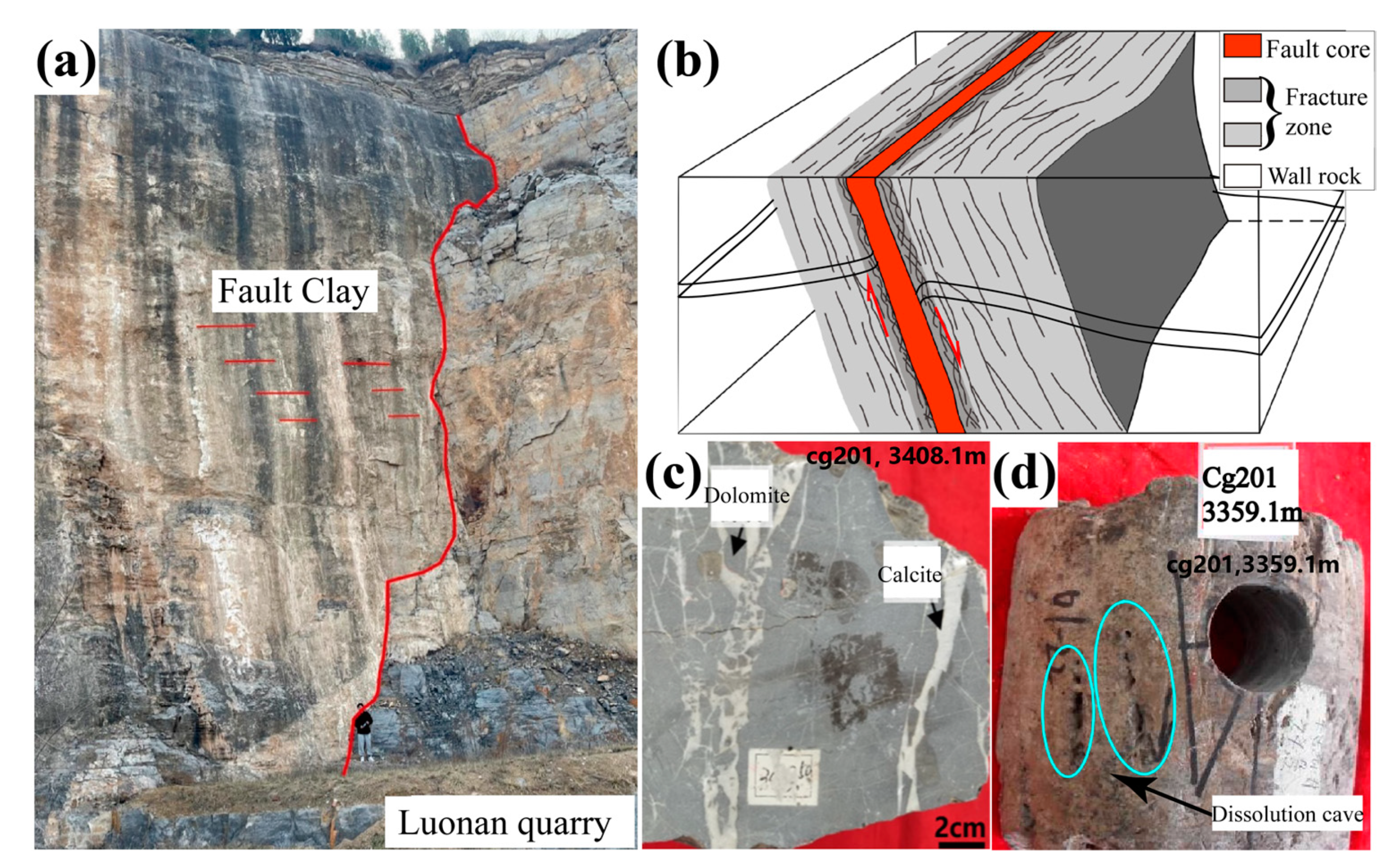
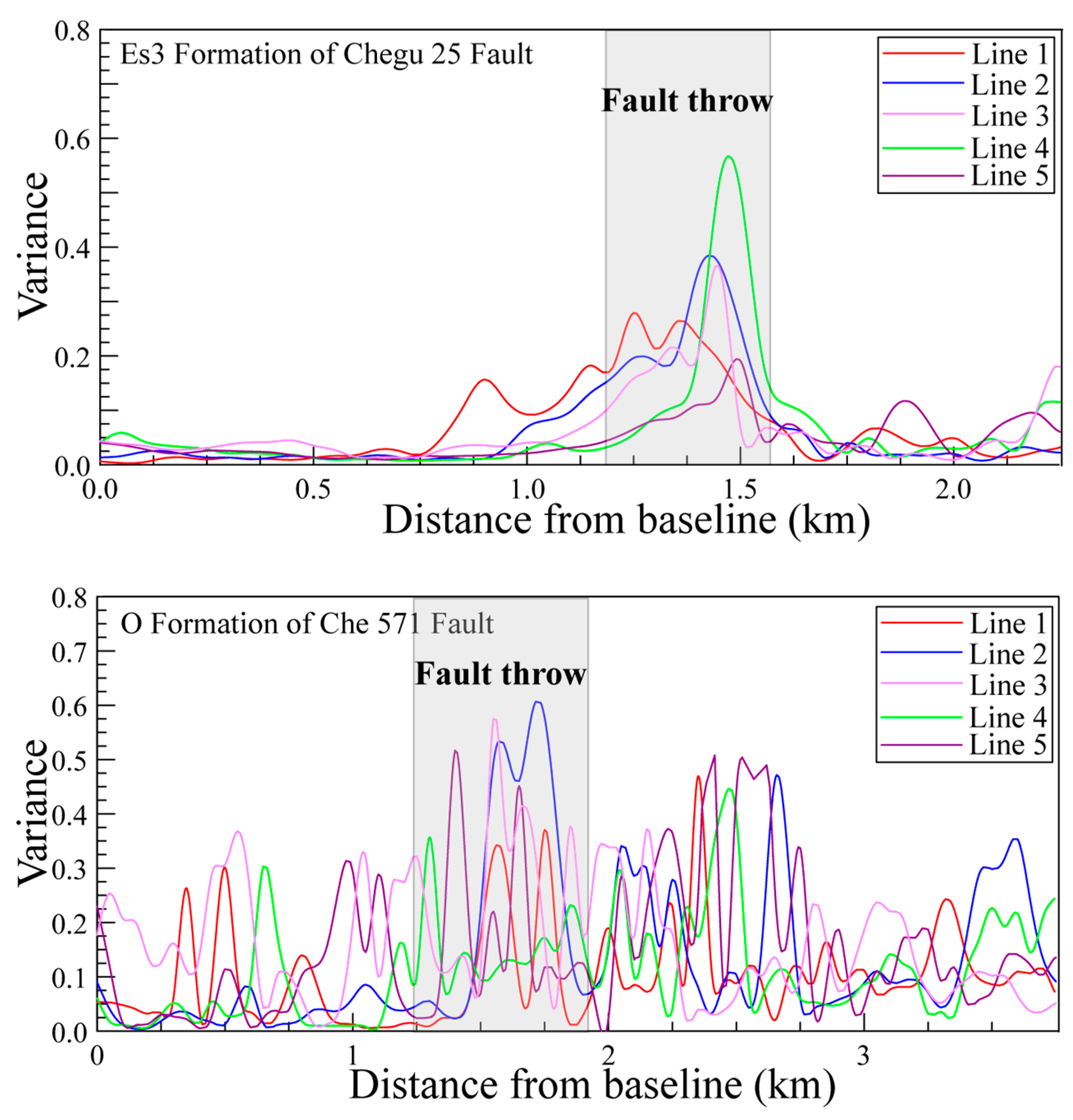
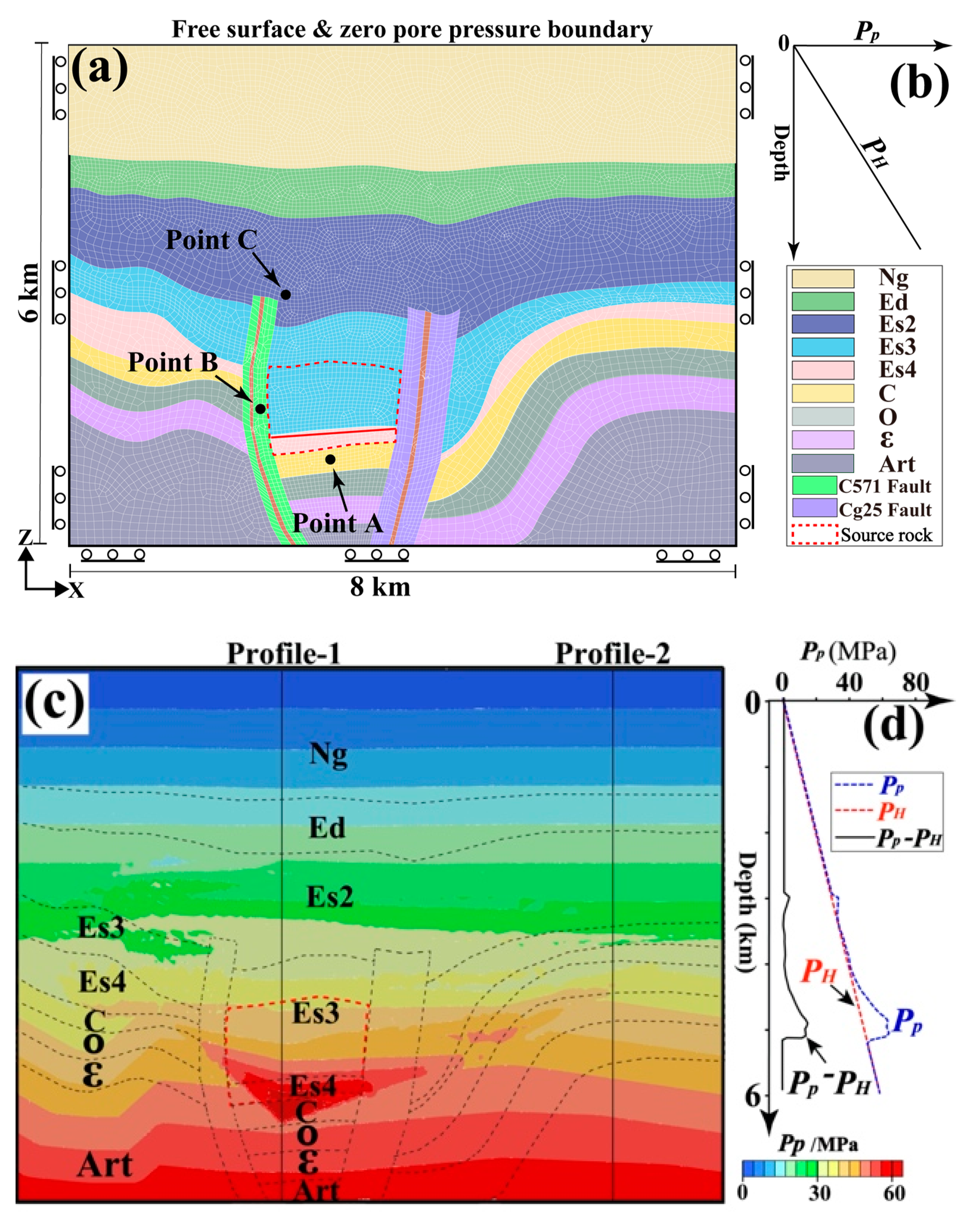
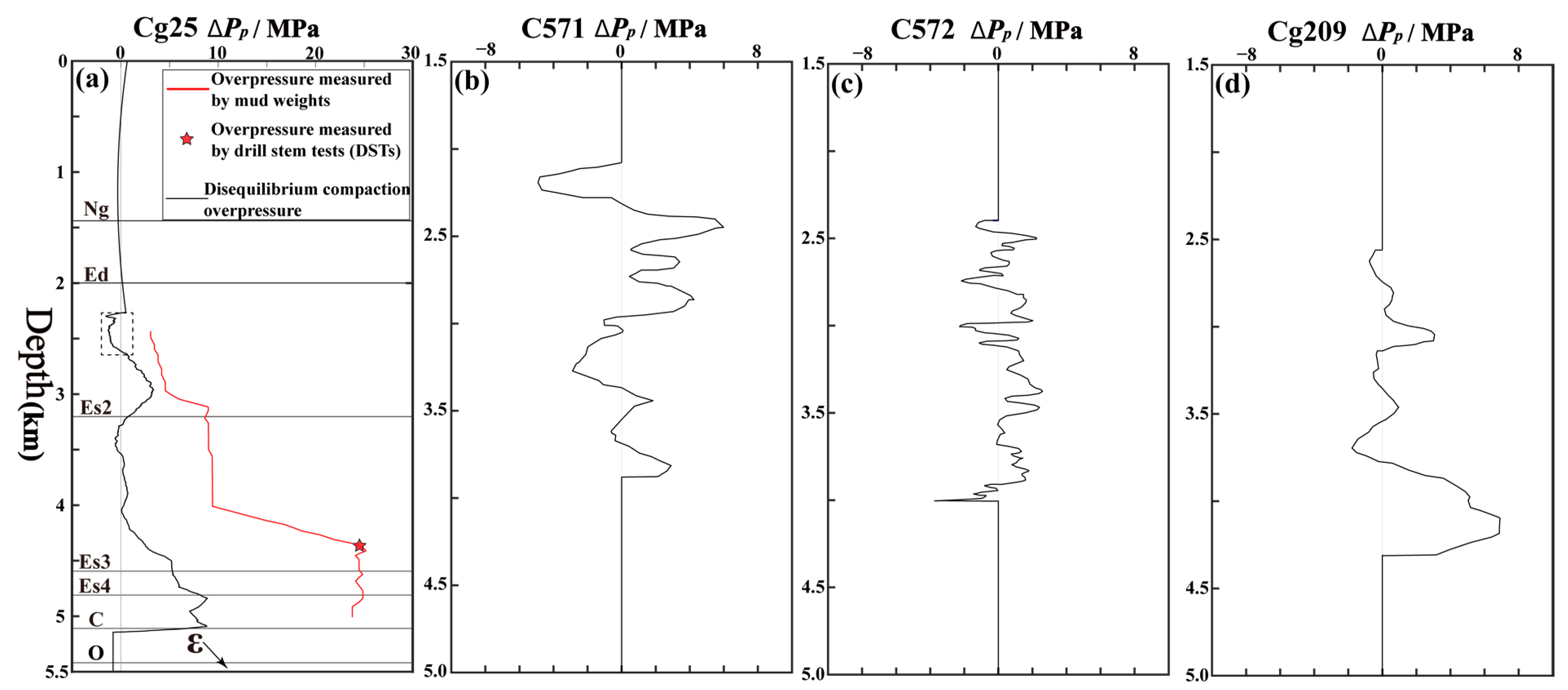
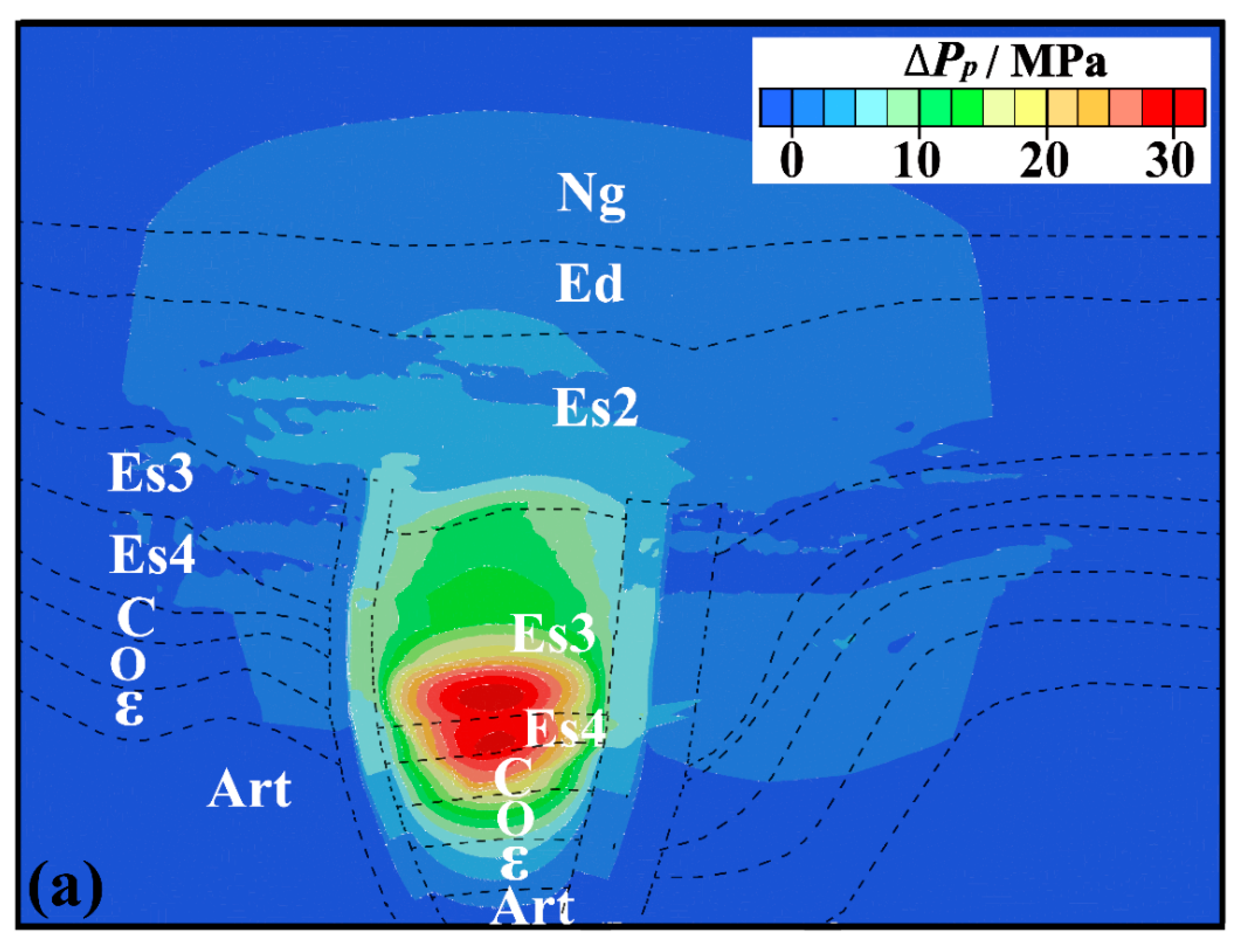
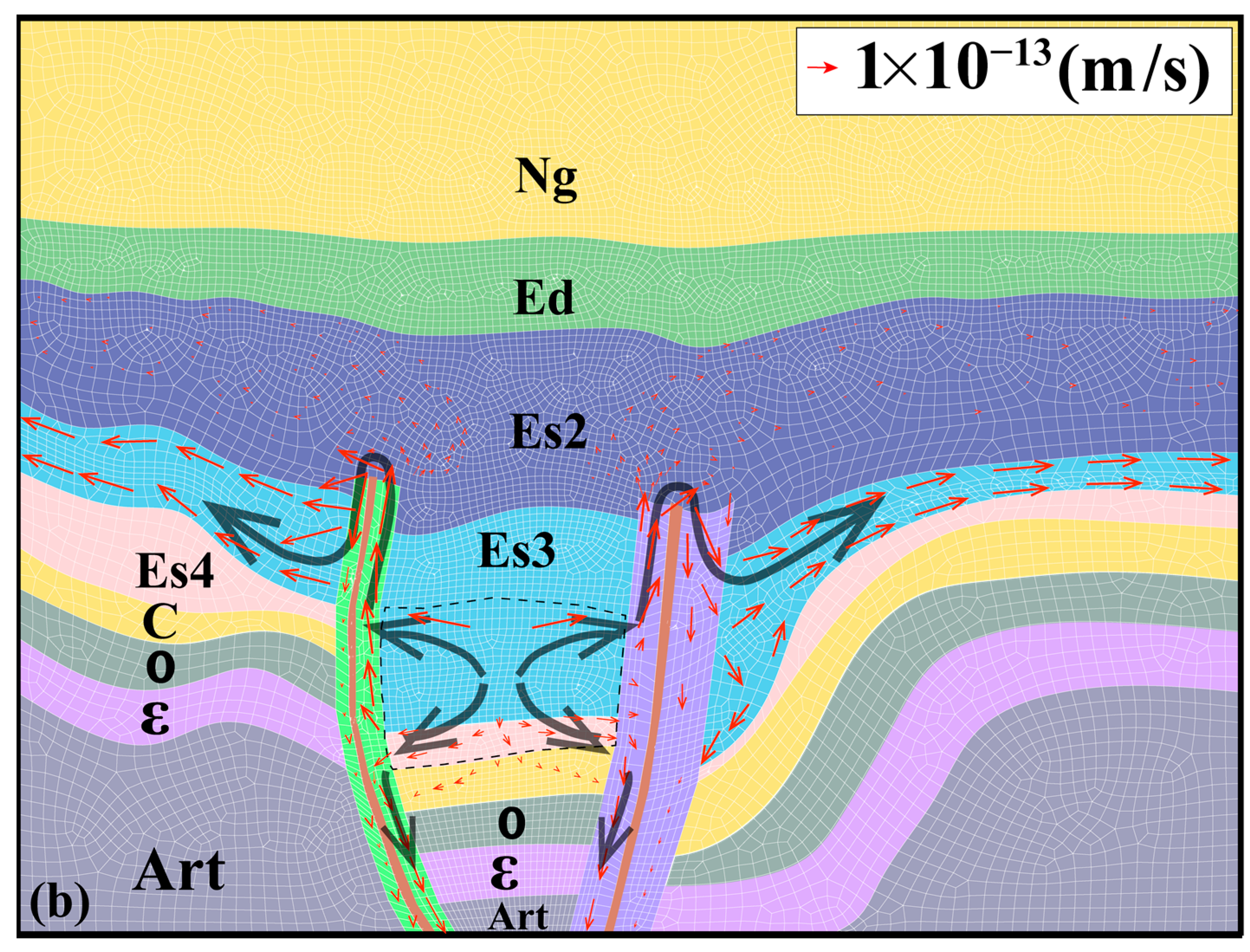
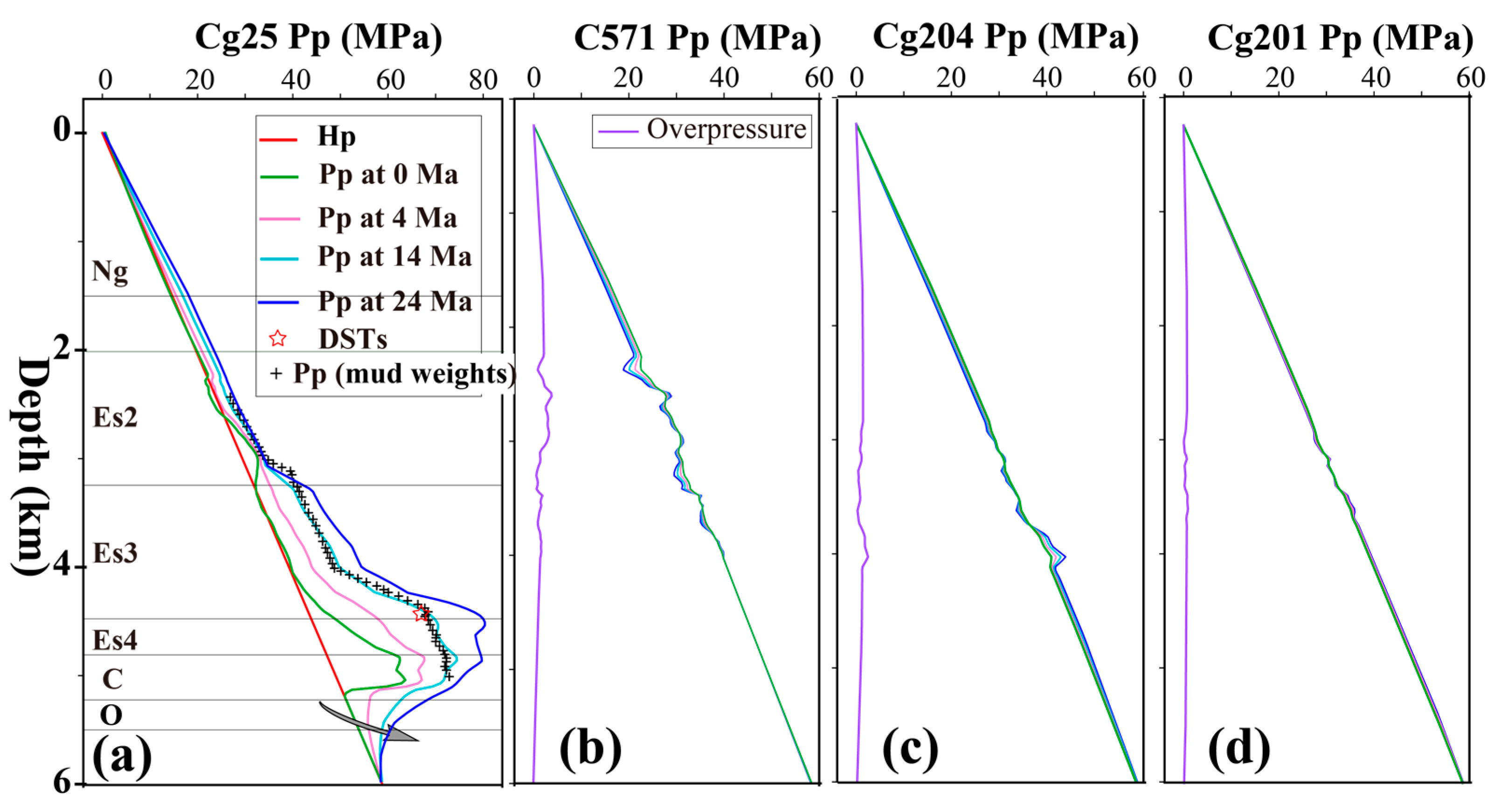

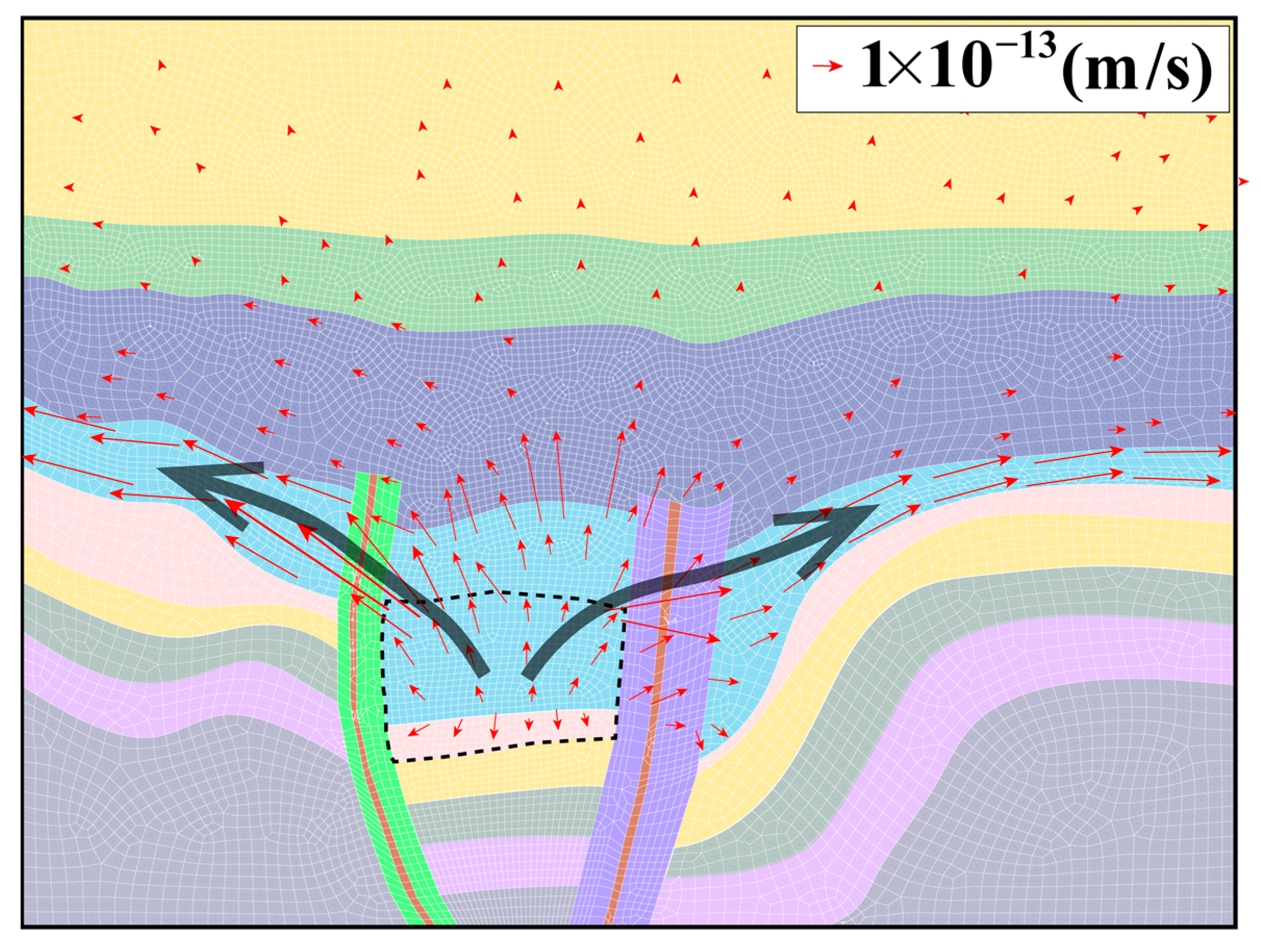

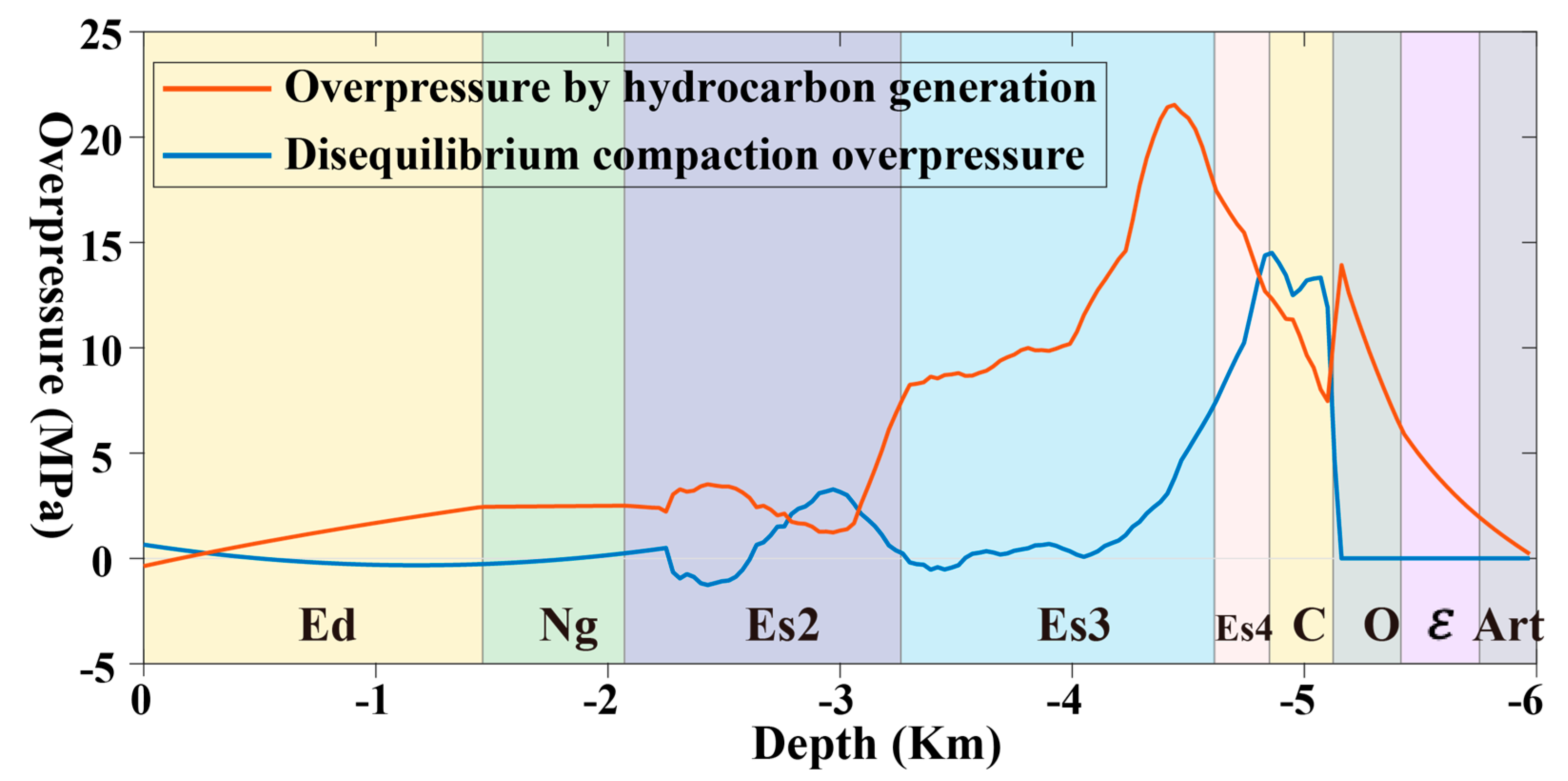
Disclaimer/Publisher’s Note: The statements, opinions and data contained in all publications are solely those of the individual author(s) and contributor(s) and not of MDPI and/or the editor(s). MDPI and/or the editor(s) disclaim responsibility for any injury to people or property resulting from any ideas, methods, instructions or products referred to in the content. |
© 2023 by the authors. Licensee MDPI, Basel, Switzerland. This article is an open access article distributed under the terms and conditions of the Creative Commons Attribution (CC BY) license (https://creativecommons.org/licenses/by/4.0/).
Share and Cite
Wang, M.; Luo, G.; Qin, F.; Liao, Z.; Zhou, S.; Yang, N. Numerical Simulation of Pore Pressure Change Caused by Hydrocarbon Generation in Chezhen Sag and Its Influence on Hydrocarbon Accumulation. Processes 2023, 11, 1976. https://doi.org/10.3390/pr11071976
Wang M, Luo G, Qin F, Liao Z, Zhou S, Yang N. Numerical Simulation of Pore Pressure Change Caused by Hydrocarbon Generation in Chezhen Sag and Its Influence on Hydrocarbon Accumulation. Processes. 2023; 11(7):1976. https://doi.org/10.3390/pr11071976
Chicago/Turabian StyleWang, Mingwen, Gang Luo, Feng Qin, Zonghu Liao, Shuhong Zhou, and Nianfa Yang. 2023. "Numerical Simulation of Pore Pressure Change Caused by Hydrocarbon Generation in Chezhen Sag and Its Influence on Hydrocarbon Accumulation" Processes 11, no. 7: 1976. https://doi.org/10.3390/pr11071976
APA StyleWang, M., Luo, G., Qin, F., Liao, Z., Zhou, S., & Yang, N. (2023). Numerical Simulation of Pore Pressure Change Caused by Hydrocarbon Generation in Chezhen Sag and Its Influence on Hydrocarbon Accumulation. Processes, 11(7), 1976. https://doi.org/10.3390/pr11071976







